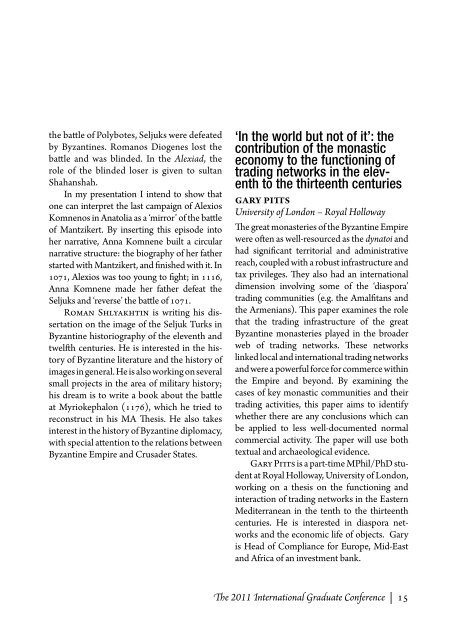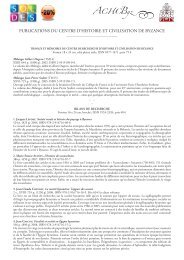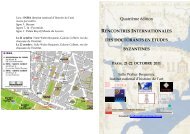booklet of abstracts - Oxford University Byzantine Society
booklet of abstracts - Oxford University Byzantine Society
booklet of abstracts - Oxford University Byzantine Society
You also want an ePaper? Increase the reach of your titles
YUMPU automatically turns print PDFs into web optimized ePapers that Google loves.
the battle <strong>of</strong> Polybotes, Seljuks were defeatedby <strong>Byzantine</strong>s. Romanos Diogenes lost thebattle and was blinded. In the Alexiad, therole <strong>of</strong> the blinded loser is given to sultanShahanshah.In my presentation I intend to show thatone can interpret the last campaign <strong>of</strong> AlexiosKomnenos in Anatolia as a ‘mirror’ <strong>of</strong> the battle<strong>of</strong> Mantzikert. By inserting this episode intoher narrative, Anna Komnene built a circularnarrative structure: the biography <strong>of</strong> her fatherstarted with Mantzikert, and finished with it. In1071, Alexios was too young to fight; in 1116,Anna Komnene made her father defeat theSeljuks and ‘reverse’ the battle <strong>of</strong> 1071.Roman Shlyakhtin is writing his dissertationon the image <strong>of</strong> the Seljuk Turks in<strong>Byzantine</strong> historiography <strong>of</strong> the eleventh andtwelfth centuries. He is interested in the history<strong>of</strong> <strong>Byzantine</strong> literature and the history <strong>of</strong>images in general. He is also working on severalsmall projects in the area <strong>of</strong> military history;his dream is to write a book about the battleat Myriokephalon (1176), which he tried toreconstruct in his MA Thesis. He also takesinterest in the history <strong>of</strong> <strong>Byzantine</strong> diplomacy,with special attention to the relations between<strong>Byzantine</strong> Empire and Crusader States.‘In the world but not <strong>of</strong> it’: thecontribution <strong>of</strong> the monasticeconomy to the functioning <strong>of</strong>trading networks in the eleventhto the thirteenth centuriesGary Pitts<strong>University</strong> <strong>of</strong> London – Royal HollowayThe great monasteries <strong>of</strong> the <strong>Byzantine</strong> Empirewere <strong>of</strong>ten as well-resourced as the dynatoi andhad significant territorial and administrativereach, coupled with a robust infrastructure andtax privileges. They also had an internationaldimension involving some <strong>of</strong> the ‘diaspora’trading communities (e.g. the Amalfitans andthe Armenians). This paper examines the rolethat the trading infrastructure <strong>of</strong> the great<strong>Byzantine</strong> monasteries played in the broaderweb <strong>of</strong> trading networks. These networkslinked local and international trading networksand were a powerful force for commerce withinthe Empire and beyond. By examining thecases <strong>of</strong> key monastic communities and theirtrading activities, this paper aims to identifywhether there are any conclusions which canbe applied to less well-documented normalcommercial activity. The paper will use bothtextual and archaeological evidence.Gary Pitts is a part-time MPhil/PhD studentat Royal Holloway, <strong>University</strong> <strong>of</strong> London,working on a thesis on the functioning andinteraction <strong>of</strong> trading networks in the EasternMediterranean in the tenth to the thirteenthcenturies. He is interested in diaspora networksand the economic life <strong>of</strong> objects. Garyis Head <strong>of</strong> Compliance for Europe, Mid-Eastand Africa <strong>of</strong> an investment bank.The 2011 International Graduate Conference | 15





